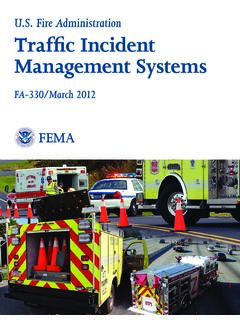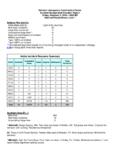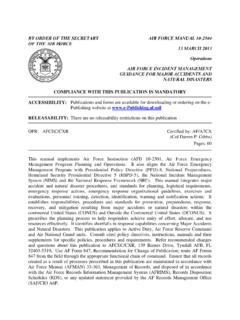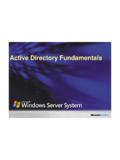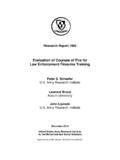Transcription of Active Shooter Response: On-Site Incident …
1 Describes a Trend Analysis as an analysis comparing similar events, activities, capacities, or capabilities over a predetermined time period to detect patterns or relationships between factors or variables. Active Shooter response : On-Site Incident Management SUMMARY The Lessons Learned Information Sharing ( ) team analyzed 30 Active Shooter After Action Reports (AARs) and identified trends in On-Site Incident management procedures during a response to an Active Shooter Incident . The Active Shooter AAR research and analysis showed that establishing On-Site Incident management during an Active Shooter Incident , in order to maintain situational awareness, is an important aspect of the response effort.
2 The analysis across the AARs indicated that the establishment of Incident Command (IC) can affect the following response capabilities: Operational Coordination Planning On-Scene Security and Protection Operation Communication To assist organizations with addressing the capabilities identified in this document, the team has provided recommended plans and resources for emergency managers. Key Findings: Establishing an Incident Commander, an Incident Command Post, and a Staging area minimizes response delays and enables asset tracking to maintain the safety of responders and promote the effective use of limited resources.
3 The consistent use of interoperable communications throughout the response efforts ensures Incident Command and on-scene responder s situational awareness is maintained as strategies are implemented and priorities evolve. 0102030 Fatality ManagementPlanningOn-Scene Security & ProtectionPublic Information & WarningOperational CommunicationMedical ResponseOperational CoordinationAfter Action Reports Trends Across Active Shooter Events Real-World AARFull-Scale AART abletop Ex AARP rimary capabilities referenced across the 30 AARs reviewed Figure 1 illustrates the frequency in which primary capabilities are referenced across the 30 AARs reviewed.
4 2 DESCRIPTION According to the Department of Homeland Security, an Active Shooter is an individual actively engaged in killing or attempting to kill people in a confined and populated area; in most cases, Active shooters use firearms(s) and there is no pattern or method to their selection of victims. i In 2012 alone, there were nine Active Shooter incidents that took place in a variety of venues, including educational institutions, places of worship, and business and entertainment establishments. The team analyzed 23 exercise AARs, published between 2008 and 2013, and seven real-world AARs and Incident reports, published between 2006 and 2013, to identify trending strengths and areas for improvements.
5 The analysis identified trends and issues regarding On-Site IC related to the following topics: Incident Commander and Command Posts Personnel and Resource Accountability Interoperable Communications Trends and Recommendations Incident Commander and Command Posts The response to an Active Shooter Incident is rapid and dynamic, making it important that on-scene personnel follow emergency response protocols to effectively and efficiently carry out operations. In order to successfully direct and control Incident management activities, the first responders on the scene should establish an Incident Commander and the location of the ICP.
6 Out of the 30 exercise AARs analyzed, 15 AARs discussed the effects of establishing an Incident Commander, setting up an ICP, and forming a Unified Command on the ability to manage the Incident . In exercises performed where IC was not properly established whether it was because an Incident Commander was never established, an ICP was not formed or because command and operational staff was not assigned cascading issues affected subsequent response operations. On-Scene Incident Management Incident Commander is the first responder on the scene who automatically takes charge of the scene. Their job is to task Command staff with identifying and assessing the problem, devising a plan to deal with it, and acquire resources to carry out the plan.
7 As the Incident progresses, the role of Incident Commander may be transferred to meet the needs of the Incident . Command Staff is responsible for management functions, including setting Incident objectives, strategies, and priorities. Additionally, Command staff is responsible for Incident safety, maintaining liaisons with other participating agencies, and providing information to stakeholders. Unified Command (UC) consists of the Incident Commanders from the various jurisdictions and disciplines operating together to form a single command structure in the field. UC forms a single IAP and coordinates together to deploy resource to meet the highest priority objectives.
8 Law Enforcement during an Active Shooter Exercise (Source: United States Air Force photo library) 3 When an Incident Commander is not formally established, the risk of information sharing gaps across disciplines increases significantly. Close to 50% of AARs reviewed reported that these information sharing gaps caused a substantial delay in what is considered a time-sensitive response . The delay is a result of not having a common operating picture to effectively manage available resources. In addition to these delays, the safety of first responders can be compromised if a common operating picture that establishes secure zones and provides the status of the Shooter (s) is not communicated to all response units.
9 To avoid these operational challenges, AAR recommendations included the following actions during response to an Active Shooter Incident : A plan for staffing a Communications Center or Incident Command Post needs to be formulated and included as part of the Active Shooter Law Enforcement response , and training on any new procedures should be conducted. ii Fire and EMS representatives should collocate with law enforcement staff to allow for a formal unified command structure. iii Have all first responding agencies personnel that would be identified in the IC/UC to come together and exercise the transition from IC to UC to make the shift routine.
10 Iv Create an Incident Action Plan (IAP) and revise it on a regular basis to maintain a consistent, up-to-date guidance across Incident command. v In all Active Shooter situations, the first person on scene after the initial entry team will establish command, and will transfer that command to a commanding officer if needed when further resources arrive. vi Utilizing personnel in Command Staff positions, as well as the different sections of ICS, will assist with information overload and dissemination. vii On September 28, 2010, an Active Shooter began firing shots on the University of Texas at Austin campus while making his way to the campus library.
